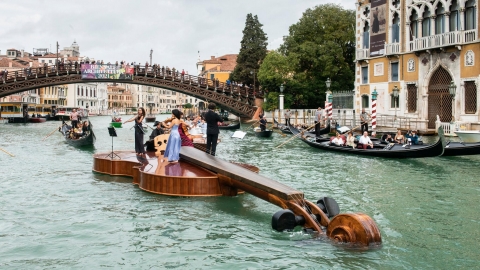Music from nature
Crisp echoes imitating the sound of cymbals, deep notes reminiscent of metal drums... these were the amazing sounds that Ethnobeat, a musical group from Siberia, created from ice on the surface of Russia's Lake Baikal in 2012. The video recording of this performance later went viral, attracting countless people around the world to the art of "ice music".
Those magical melodies of ice have also appeared on pitch-black nights across the Arctic territories of Norway and Sweden many years ago. In 2000, Norwegian composer and artist Terje Isungset performed the world's first ice concert, inside a frozen waterfall in Lillehammer.
Six years later, Isungset founded the Music on Ice Festival (Ice Music Festival Norway), attracting curious explorers willing to brave sub-zero temperatures to experience a unique connection with nature through music. The festival, originally scheduled for this winter, was cancelled due to the Covid-19 pandemic, but will still be held from February 4 to February 6, 2022.
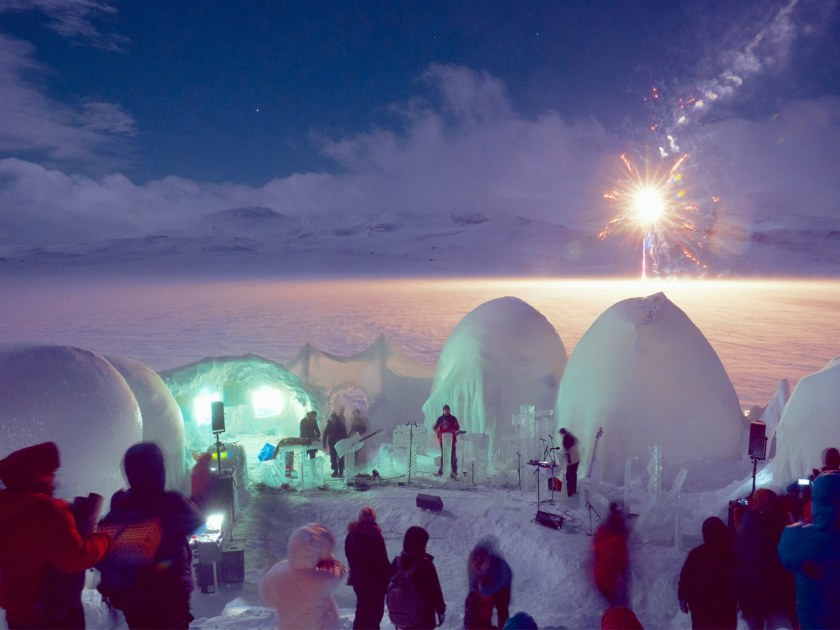
February 2020, the closing performance of the Ice Music Festival ended in the village of Finse, near the Hardangerjøkulen glacier, Norway - Photo: Emile Holba
For Isungset, an artist with a history of using natural gifts like wood and stone to create, using ice was a breakthrough in his music-making journey. “The first time I played music on a transparent ice surface, I was amazed by the pure, warm and gentle sound. A sound completely different from the cold, crumbling sound of ice under our feet,” he said.
To date, Isungset has performed hundreds of ice concerts, including at the Nobel Banquet in 2017. He has recorded eight albums under the name All Ice Records, and has fully embraced the art form as his life's work.
So, what exactly is ice music? It is when artists use ice to percuss, or play instruments crafted from ice. Many of these instruments may seem familiar to us, but when made from ice, they enhance the beauty of nature, and produce many unpredictable notes. Both the making and the use of these instruments are processes that cannot be precisely controlled. This adds to the appeal of this art form.
Musical instrument making
The carved instruments can be made entirely of ice, such as horns and percussion instruments, or a combination of ice and other materials, such as harps, which have ice bodies with metal strings attached. Isungset collaborates with ice sculptor Bill Covitz, an artist based in the United States who visits concert venues around the world, to create instruments that are uniquely local.
Another American artist, Tim Linhart, focused on ice and snow sculptures in the US, before moving to Europe and becoming known for his ice musical instruments. In his 36 years of creation, he has created hundreds of musical instruments, performed in 19 ice orchestras, and performed 11 igloo-style concerts in places ranging from Luleå, Sweden, to the Italian Alps.
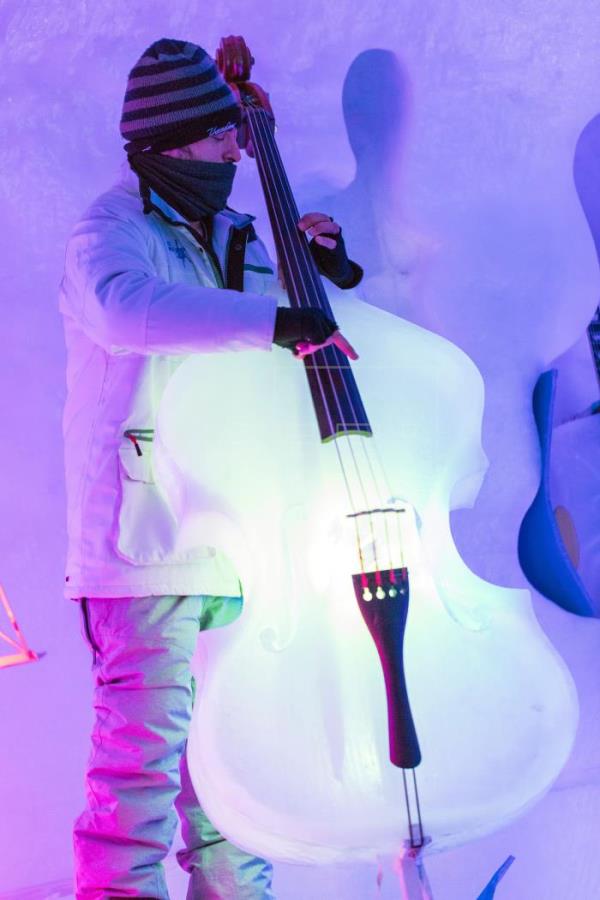
Artists performing at the Music on Ice Festival on February 10, 2019

Photo: EFE-EPA/Gabriele Debetto

By studying and mixing icy materials – such as clear ice and homemade sparkling water, along with mountain snow – Linhart can create complex instruments like violins, and tune them as perfectly as possible. It's a process he calls “ice engineering.”
Years of ice sculpting have taught him the pros and cons of this particular material. “When you reach the limit between the tension of the string and the thickness of the material, that’s when the music really comes out,” Linhart has learned through trial and error, and even shattering instruments.
Currently living and working in Italy, the artist has built a professional orchestra that can play almost any genre of music, from rock-and-roll to classical, with instruments made from ice.

Photo: Tim Linhart
Sculpting ice instruments can take anywhere from three days to several weeks, as harvesting the materials and ensuring their quality are all dependent on the weather. Like wine, some years produce great results. Other years, Mother Nature chooses not to sing.
Play it right
Once the performance begins, other complications arise. “The ice is always moving,” Linhart says. “Body heat gradually melts the instruments. The air temperature increases because of the audience’s breathing. Different instruments then need to be tuned differently. This one needs to be down, that one needs to be up.” To minimize this as much as possible, he designed the concert venues with domes, which prevent the heat from concentrating on the orchestra.
Another danger? When playing the instrument, the player's lips can get stuck to the instrument, as it is made of ice! And in most cases, musicians cannot practice on the instrument in advance, so they often improvise live in front of the audience. This makes every performance unique.
“I find the crisp sound of ice instruments fascinating and special. But their possibilities are very limited, as there are no pedals or levers to adjust while playing, or during breaks between pieces,” says Anna-Maria Hefele, a German musician who is experimenting with ice harps.
That also means playing it right to avoid having the entire performance consist of just one melody repeating over and over again.
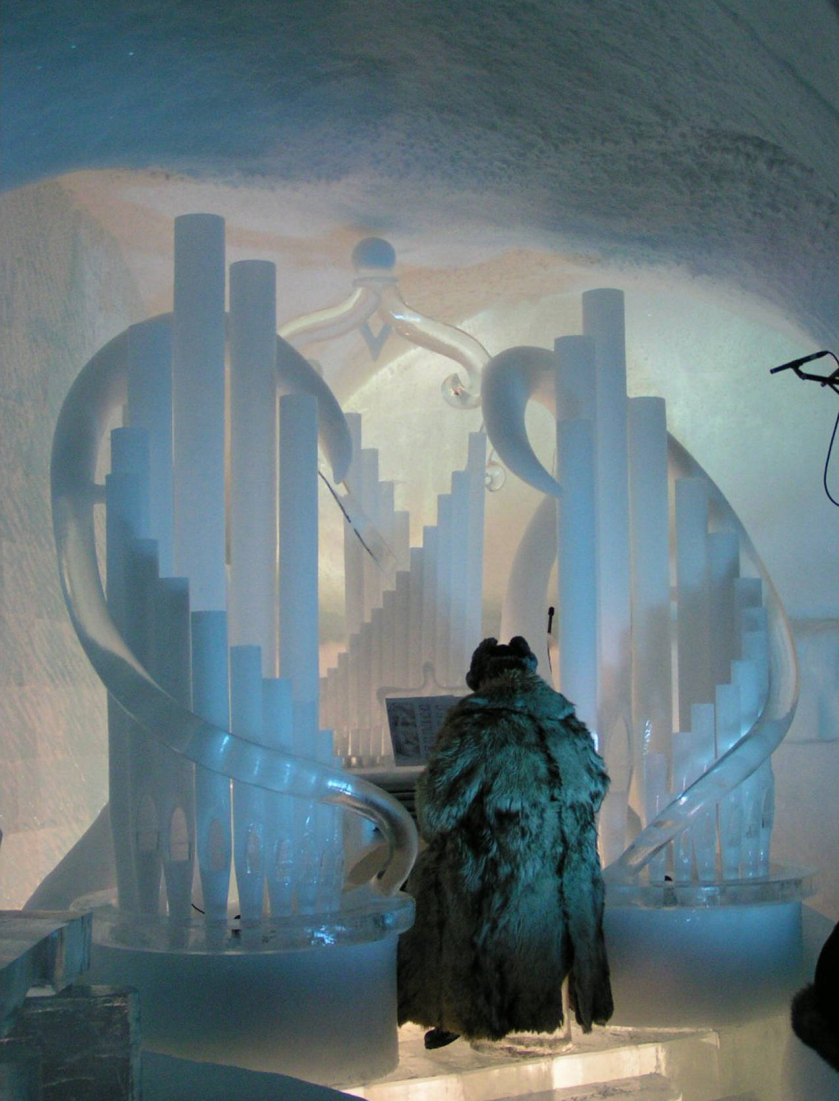
Photo: Tim Linhart
Traditional harpists are still admired for their ability to pluck the instrument deftly and create elegant melodies. But with an ice harp, the temperature of the fingers affects the sound of the instrument. "The problem is, the harpist needs warm hands to move quickly and accurately. If the hands are cold, the rhythm cannot be controlled, and if the hands are hot, the harp will melt," Hefele lamented.
Creating music from tape comes with a lot of quirks, but many artists see it as an opportunity to refine their skills and nurture their creativity.
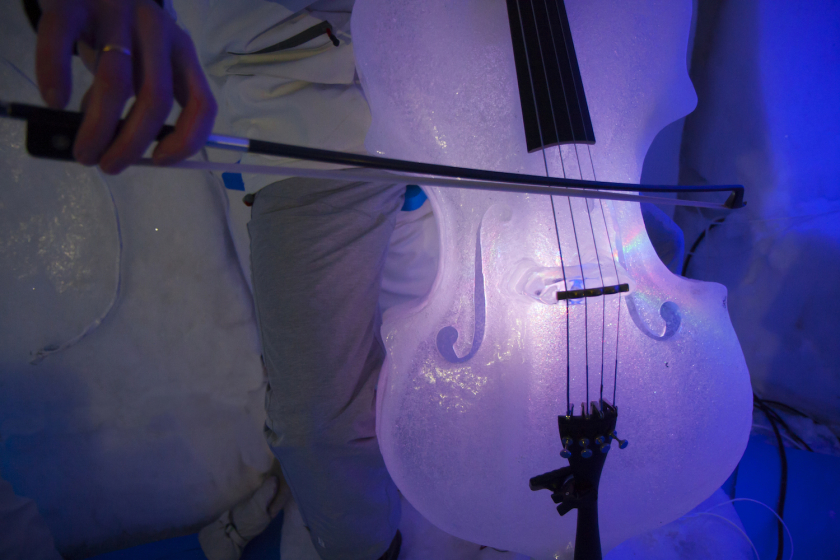
Photo: Tim Linhart
“I always like new challenges and exploring different musical genres,” says Viktor Reuter, a Swedish double bassist who has toured Norway, Germany, and China with Isungset. “When you play a wooden double bass, your body is always in contact with the wood, and you can feel its vibrations.” But with a thicker, heavier tape, the bass sounds completely different. The harmonies have to be simplified and played slower, requiring improvisation and a constant state of mind.
Music and messages from the tape
Making and maintaining instruments, preparing venues, and drawing audiences into cold spaces are all challenging endeavors. For these particular artists, it’s their job to adapt to the unpredictable. They often have to improvise their music live, without rehearsal.
In addition to touring China, Isungset and his band perform around 70 concerts a year around the world, from Australia and Japan to India and the United States. Often they cannot perform outdoors, and must use freezers to preserve their instruments. Meanwhile, Linhart is trying to bring this magical art form to the 2026 Winter Olympics, scheduled to be held in Italy.

Building the venue for the 2020 Ice Music Festival - Photo: Emile Holba
For Isungset, it’s not just about music, it’s about environmental action. He’s partnered with the Bergen-based Bjerknes Climate Research Centre to host discussions and art installations about the impact of climate change on ice at his own Music on Ice Festival.
“The most important thing for us is the abstraction of our performance art. Instead of talking to people about what not to do, we share the message in a subtle way,” Isungset said. The instruments themselves are also a metaphor for global warming, as they will melt away every spring when the audience has finished enjoying the music and leaves.
After all, "making music from ice is not an artificial thing, but a performance directed entirely by nature."























